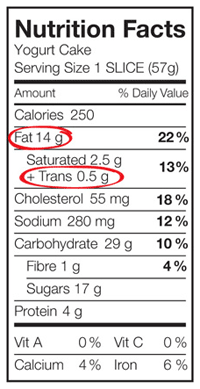

- Why are pre-packaged food products with a Nutrition Facts table, sold or offered directly to consumers, without alteration by the Food Service Operator, exempt from the trans fat regulation?
- Does a food that says “trans fat free” meet BC’s trans fat restrictions?
- Should I only buy food with a “trans fat free” claim to be sure I meet the 2% and 5% restrictions?
- Can I use the “% Daily Value” on the Nutrition Facts table to see if my products meet the 2% and 5% restrictions?
- What if a food in my establishment does not come with any documentation?
- What about products imported from the U.S. and other countries?
- The nutrition information I have for a box of crackers gives me different amounts of trans fat depending on the serving size (e.g. per 2 cracker serving vs. per 100g). What information do I use?
- Why does some food have a source of industrially produced trans fat in the ingredient list, but the Nutrition Facts table says “0g” of trans fat?
- The nutrition facts table on a product says “Not a significant source of trans fat”, but doesn’t list the exact amount of trans fat. What does this mean and how do I know if the food meets the restrictions?
Why are pre-packaged food products with a Nutrition Facts table, sold or offered directly to consumers, without alteration by the Food Service Operator, exempt from the trans fat regulation?
Pre-packaged food with a Nutrition Facts table required under the Food and Drugs Act (Canada) show the amount of trans fat per serving so that consumers can easily identify the amount of trans fats by reading the label.
Does a food that says “trans fat free” meet BC’s trans fat restrictions?
Yes. A food that says “trans fat free” will meet both the 2% and 5% trans fat restrictions. However, you must also have the ingredient list, Nutrition Facts table or product specification sheet for all food on site to show an Environmental Health Officer that your food meets the restrictions.
The claim “trans fat free” is a federally regulated claim separate from the BC trans fat regulation. For more information on nutrient content claims, visit the Canadian Food Inspection Agency Website - Nutrient Content Claims.
Should I only buy food with a “trans fat free” claim to be sure I meet the 2% and 5% restrictions?
No. Since the claim “trans fat free” is not mandatory on labels and manufacturers can choose to use it or not; there are many other food products that can be used in your establishment that do not necessarily carry this claim. It’s important to check with your supplier to see if the food meets the restrictions and to verify the paperwork.
Can I use the “% Daily Value” on the Nutrition Facts table to see if my products meet the 2% and 5% restrictions?
No. The % Daily Value (DV) is used by the consumer to see whether a food has a little or a lot of a nutrient(s) based on an individual’s daily nutritional requirements. The % DV is not related to the trans fat restrictions.
What if a food in my establishment does not come with any documentation?
According to federal law, documentation for all food must be provided to you as a food service establishment at each delivery. If a product does not have an ingredient list and Nutrition Facts table on the package itself, ask your supplier for a product specification sheet.
For more information visit the Canadian Food Inspection Agency Website - Information Letter - Accompanying Documentation for Nutrition Labelling.
What about products imported from the U.S. and other countries?
A Canadian ingredient list, a Nutrition Facts table, or a product specification sheet is required for all food imported into Canada. Ask your manufacturer for documentation.
By law, all food imported into Canada must be labelled according to Canadian regulations. If you have an inquiry or complaint about products that are not in compliance with the labelling requirements, contact the nearest Canadian Food Inspection Agency office:
- Canadian Food Inspection Agency - Burnaby Office
Telephone: 604-666-5513
- Canadian Food Inspection Agency - Kelowna Office
Telephone: 250-470-4884
- Canadian Food Inspection Agency - Victoria Office
Telephone: 250-363-3455
- Canadian Food inspection Agency - Toronto Office
Telephone: 416-665-5055
- Ontario Canadian Food Inspection Agency Labelling
Telephone: 1-800-667-2657
The nutrition information I have for a box of crackers gives me different amounts of trans fat depending on the serving size (e.g. per 2 cracker serving vs. per 100g). What information do I use?
Use the nutrition information on the ingredient list and Nutrition Facts table first. If this information is not available, use the product specification sheet.
In the case that the food label or product specification sheet has nutrition information on both a 100g and a per serving basis, use the information given on a per serving basis.
Why does some food have a source of industrially produced trans fat in the ingredient list, but the Nutrition Facts table says “0g” of trans fat?
In this situation, the food contains a very small amount of industrially produced trans fat, so the amount is rounded to zero.
The nutrition facts table on a product says “Not a significant source of trans fat”, but doesn’t list the exact amount of trans fat. What does this mean and how do I know if the food meets the restrictions??
Products with the clause “Not a significant source of trans fat…” should be treated as having 0g of trans fat, and therefore compliant with the trans fat restrictions. A product specification sheet outlining the exact amount of trans fat for these sorts of products is not required---the simplified Nutrition Facts Table is an acceptable form of documentation and the product would be treated as having no trans fat.

